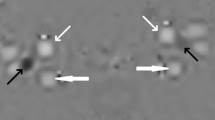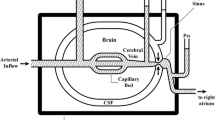Abstract
Background
It is thought that the internal jugular veins (IJV) are the primary route for cranial venous outflow in supine position and the vertebral venous plexus when upright. Previous studies have noted a greater increase in intracranial pressure (ICP) when subjects turn their head in one direction compared to the other, but no clear cause had been investigated. We hypothesised that in the supine position, head turning and consequently obstructing the IJV draining the dominant transverse sinus (TVS) would lead to a greater rise in ICP compared to turning to the non-dominant side.
Methods
A prospective study in a large-volume neurosurgical centre. Patients undergoing continuous ICP monitoring as part of their standard clinical management were recruited. Immediate ICP was measured in different head positions (neutral, rotated to the right and left) when supine, seated, and standing. TVS dominance was established by consultant radiologist report on venous imaging.
Results
Twenty patients were included in the study, with a median age of 44 years. Venous system measurements revealed 85% right-sided vs 15% left-sided dominance. Immediate ICP rose more when head turning from neutral to the dominant TVS (21.93mmHg ± 4.39) vs non-dominant side (16.66mmHg ± 2.71) (p= <0.0001). There was no significant relationship in the sitting (6.08mmHg ± 3.86 vs 4.79mmHg ± 3.81, p = 0.13) or standing positions (8.74mmHg ± 4.30 vs 6.76mmHg ± 4.14, p =0.07).
Conclusion
This study has provided further evidence that the transverse venous sinus to internal jugular system pathway is the likely primary venous drainage when supine; and quantified its effect when head turning on ICP. It may guide patient-specific nursing care and advice.



Similar content being viewed by others
Data availability
Not applicable.
Abbreviations
- ICP:
-
intracranial pressure
- CTV:
-
computed tomography venography
- MRV:
-
magnetic resonance venography
- IJV:
-
internal jugular vein
- TVS:
-
transverse venous sinus
- IIH:
-
Idiopathic intracranial hypertension
References
Alper F, Kantarci M, Dane S, Gumustekin K, Onbas O, Durur I (2004) Importance of anatomical asymmetries of transverse sinuses: an MR venographic study. Cerebrovasc Dis 18(3):236–239. https://doi.org/10.1159/000079960
Alperin N, Lee SH, Sivaramakrishnan A, Hushek SG (2005) Quantifying the effect of posture on intracranial physiology in humans by MRI flow studies. J Magn Reson Imaging 22(5):591–596. https://doi.org/10.1002/jmri.20427
Altafulla JJ, Prickett J, Iwanaga J, Dumont AS, Tubbs RS (2020) Intraluminal anatomy of the transverse sinus: implications for endovascular therapy. Anat Cell Biol 53(4):393–397. https://doi.org/10.5115/acb.20.041
Boddu SR, Gobin P, Oliveria C, Dinkin M, Patsalides A (2018) Pressure variations in cerebral venous sinuses of idiopathic intracranial hypertension patients. J Vasc Interv Neurol 10(1):25–30
Burbridge MA, Min JG, Jaffe RA (2019) Effect of Head Rotation on Jugular Vein Patency Under General Anesthesia. Can J Neurol Sci 46(3):355–357. https://doi.org/10.1017/cjn.2019.13
Dinkin M, Oliveira C (2019) Men Are from Mars, Idiopathic Intracranial Hypertension Is from Venous: The Role of Venous Sinus Stenosis and Stenting in Idiopathic Intracranial Hypertension. Semin Neurol 39(6):692–703. https://doi.org/10.1055/s-0039-3399506
Duffus S et al (2015) Unusual Extensive Collateral Venous Network in a Patient with Multiple Cerebral Venous Thromboses (P5.121). Neurology 84
Durgun B, Ilglt ET, Cizmeli MO, Atasever A (1993) Evaluation by angiography of the lateral dominance of the drainage of the dural venous sinuses. Surg Radiol Anat 15(2):125–130. https://doi.org/10.1007/BF01628311
Durst CR, Ornan DA, Reardon MA et al (2016) Prevalence of dural venous sinus stenosis and hypoplasia in a generalized population. J Neurointerv Surg 8(11):1173–1177. https://doi.org/10.1136/neurintsurg-2015-012147
Gisolf J, van Lieshout JJ, van Heusden K, Pott F, Stok WJ, Karemaker JM (2004) Human cerebral venous outflow pathway depends on posture and central venous pressure. J Physiol 560(Pt 1):317–327. https://doi.org/10.1113/jphysiol.2004.070409
Gooding CA, Stimac GK (1984) Jugular vein obstruction caused by turning of the head. AJR Am J Roentgenol 142(2):403–406. https://doi.org/10.2214/ajr.142.2.403
Holmlund P, Johansson E, Qvarlander S et al (2017) Human jugular vein collapse in the upright posture: implications for postural intracranial pressure regulation. Fluids Barriers CNS 14(1):17. Published 2017 Jun 17. https://doi.org/10.1186/s12987-017-0065-2
Mavrocordatos P, Bissonnette B, Ravussin P (2000) Effects of neck position and head elevation on intracranial pressure in anaesthetized neurosurgical patients: preliminary results. J Neurosurg Anesthesiol 12(1):10–14. https://doi.org/10.1097/00008506-200001000-00003
Mitchell, P.H. et al. (1986). Nursing and ICP: Studies of two Clinical Problems. In: Miller, J.D., Teasdale, G.M., Rowan, J.O., Galbraith, S.L., Mendelow, A.D. (eds) Intracranial Pressure VI. https://doi.org/10.1007/978-3-642-70971-5_134
Monro A (1783) Observations on the structure and functions of the nervous system, illustrated with tables. Lond Med J 4(2):113–135
Perez-Barcena J, Llompart-Pou JA, O'Phelan KH (2014) Intracranial pressure monitoring and management of intracranial hypertension. Crit Care Clin 30(4):735–750. https://doi.org/10.1016/j.ccc.2014.06.005
Valdueza JM, von Münster T, Hoffman O, Schreiber S, Einhäupl KM (2000) Postural dependency of the cerebral venous outflow. Lancet 355(9199):200–201. https://doi.org/10.1016/s0140-6736(99)04804-7
Watson GH (1974) Effect of head rotation on jugular vein blood flow. Arch Dis Child 49(3):237. https://doi.org/10.1136/adc.49.3.237
Williams A, Coyne SM (1993) Effects of neck position on intracranial pressure. Am J Crit Care 2(1):68–71
Code availability
Not applicable.
Author information
Authors and Affiliations
Corresponding author
Ethics declarations
Ethics approval
Research ethics committee (REC) reference: 16/WM/0156.
Consent for publication
Gained.
Conflict of interest
The authors declare no competing interests.
Additional information
Publisher’s note
Springer Nature remains neutral with regard to jurisdictional claims in published maps and institutional affiliations.
Rights and permissions
Springer Nature or its licensor (e.g. a society or other partner) holds exclusive rights to this article under a publishing agreement with the author(s) or other rightsholder(s); author self-archiving of the accepted manuscript version of this article is solely governed by the terms of such publishing agreement and applicable law.
About this article
Cite this article
Khawari, S., Al-Mohammad, A., Pandit, A. et al. ICP during head movement: significance of the venous system. Acta Neurochir 165, 3243–3247 (2023). https://doi.org/10.1007/s00701-023-05620-8
Received:
Accepted:
Published:
Issue Date:
DOI: https://doi.org/10.1007/s00701-023-05620-8




